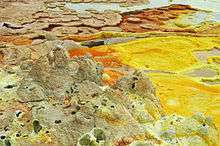Dallol (volcano)
| Dallol | |
|---|---|
 | |
| Highest point | |
| Elevation | −48 m (−157 ft) |
| Coordinates | 14°14′30″N 40°18′00″E / 14.24167°N 40.30000°E |
| Geography | |
| Location | Ethiopia |
| Parent range | Danakil Depression |
| Geology | |
| Mountain type | Explosion craters |
| Last eruption | 1926 |
Dallol is a volcanic explosion crater (or maar) in the Danakil Depression, northeast of the Erta Ale Range in Ethiopia. It has been formed by the intrusion of basaltic magma into Miocene salt deposits and subsequent hydrothermal activity.[1] Phreatic eruptions took place here in 1926, forming Dallol Volcano; numerous other eruption craters dot the salt flats nearby. These craters are the lowest known subaerial volcanic vents in the world, at 45 m (150 ft) or more below sea level. The most recent major activity was in October 2004 when the shallow magma chamber beneath Dallol deflated and fed a magma intrusion southwards beneath the rift.[2]
Numerous hot springs are discharging brine and acidic liquid here. Small, widespread, temporary geysers produce cones of salt.
The term Dallol was coined by the Afar people and means dissolution or disintegration, describing a landscape of green acid ponds (pH-values less than 1) and iron oxide, sulfur and salt desert plains. The area resembles the hot springs areas of Yellowstone Park.
Gallery
 The Danakil desert seen from Dallol.
The Danakil desert seen from Dallol. Salt and sulfur formations at Dallol.
Salt and sulfur formations at Dallol.
See also
- List of volcanoes in Ethiopia
- Dallol – a ghost town in the Dallol crater. It had the record high average temperature for an inhabited location on Earth.
References
- ↑ "Dallol salt springs and geysers". Wondermondo.
- ↑ Nobile, A; Pagli, C; Keir, D; Wright, TJ; Ayele, A; Ruch, J; Acocella, A (October 2012). "Dike-fault interaction during the 2004 Dallol intrusion at the northern edge of the Erta Ale Ridge (Afar, Ethiopia)". Geophysical Research Letters. 39 (19). doi:10.1029/2012GL053152.
- "Dallol". Global Volcanism Program. Smithsonian Institution.
- On the Volcanoes of the World episode The Horn of Africa (2008; Science Channel)
External links
| Wikimedia Commons has media related to Dallol. |